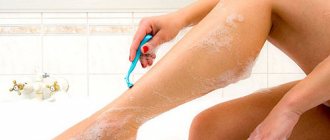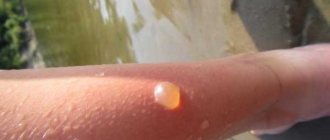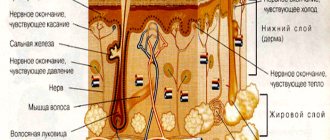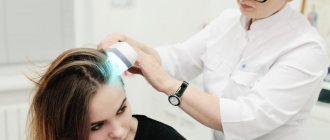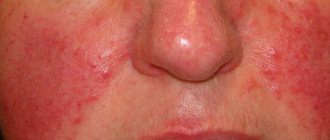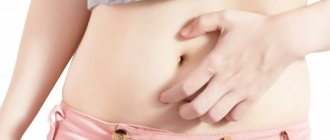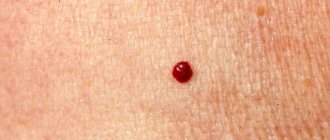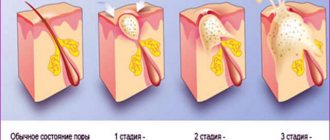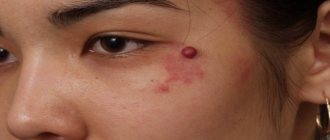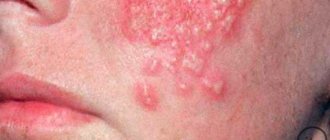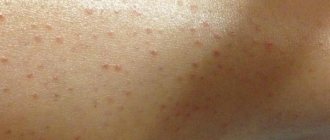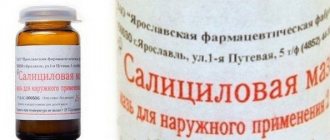Bumps, bumps and pimples on the body
Pimples on the body appear as a consequence of various negative processes hidden in the body. These include an allergic reaction, the consequences of mechanical damage, the presence of viral and bacterial infections in the body. It is well known that the skin, like litmus paper, reflects the condition of internal organs and tissues.
Bumps on the skin
Lumps can appear on different parts of the skin: face, legs, arms, all over the skin and have various causes. Children, men and women are susceptible to this. Often they are practically invisible on the epidermis, but cause a lot of inconvenience: they itch and itch.
The cause is often a metabolic disorder in the body, poor quality nutrition, lack of vitamins, and non-compliance with hygiene rules. Infections and subcutaneous mites can also provoke the appearance of pimples and pimples. Let's look at some of the reasons why bumps (pimples) appear on the skin.
Keratosis follicularis
In most cases, simple bumps can be the first stage of keratosis pilaris (goose bumps), the second stage is the appearance of blood around the hair follicles, resulting in red dots appearing on top of the bumps. This is an elementary lack of vitamins C, D, A and as a result, the so-called goose bumps appear.
With this disease, excessively rapid skin renewal occurs. Dead particles of the epidermis do not have time to exfoliate and accumulate near the hair follicle, forming a dense seal, blocking the germination of new hairs, which curl up and form nodules.
The disease may begin in early childhood, but goes away over time. The primary symptom is dry skin, especially on the feet and palms. As the disease develops, skin lesions can be localized in certain areas: mostly on the arms from the elbow to the forearm, buttocks, thighs, or throughout the body.
It has not yet been possible to establish the cause of the disease. It is believed that heredity contributes to this. Since close relatives are most often affected by goose bumps. Provoking factors may include:
- Winter season. At this time, an exacerbation of follicular keratosis occurs. In summer, the skin becomes clearer.
- Taking hormonal drugs.
- Lack of vitamins C, D, A in the body.
- Strict diets, unbalanced nutrition.
- Stress that provokes disorders in the body, including the skin.
Other diseases have similar symptoms, in particular, keratoderma and Darier's disease.
Follicular keratosis is a cosmetic skin disease, since it does not bring any special problems to a person, apart from its unaesthetic appearance.
Wen
A rash of small pimples on the skin of the face and body often turns out to be wen, which in medicine is called “Lipoma” - a benign formation that does not cause harm to a person, except for cosmetic discomfort. Wen look like white pimples on the face. You cannot crush them yourself, as there is a risk of infection. And after this, the wen will again quickly fill with subcutaneous fat.
Today, there are many methods for removing lipomas, which are performed by dermatologists or surgeons. You can reduce the size of the wen using special creams.
Milia
Often a small cyst, called a milia, appears under the skin. As a result, small bumps form on the skin, which are located singly or in groups. Only a doctor can remove them, since squeezing will not lead to results.
When removing, a procedure called “Dermabrasion” is prescribed. In other words, the surface layer of the skin is polished. The operation carried out brings the patient a certain amount of pain that can be tolerated. After sanding, red spots remain on the skin, which disappear after a few days.
Hyperplasia of the sebaceous glands
On fairly oily skin, small bumps appear. This occurs due to the growth of sebaceous glands. They differ from simple wen in their flesh color, plastic state and small hole on top. With hyperplasia, the skin takes on a lumpy appearance and becomes a little dense. No inflammation of the epidermis is observed. They are removed with liquid nitrogen or cauterized with an electric current.
Subcutaneous comedones
A comedon looks like a clogged sebaceous plug that forms on the skin and looks like a flesh-colored tubercle. Groups of comedones are located not only on oily areas of the skin, but also on the temples, cheeks, and cheekbones. If you do not clean the skin for a long time, suppuration may appear and the bumps turn into reddish pimples.
Their appearance is due to insufficient cleansing of the skin. You can cleanse your face of subcutaneous comedones using scrubs and face wash foams. Noticeable results are achieved by special facial cleansing procedures in beauty salons.
Demodex skin infection
Lumpy skin may indicate that demodex, a subcutaneous mite that lives in or near the hair follicles, has settled underneath it. A sign of infection is severe itching, especially at night.
Skin scraping will help confirm its presence. The bumps formed due to the presence of the mite are reddish in color, and the skin around the head of the pimple is inflamed.
Treatment is carried out with antiparasitic drugs.
Molluscum contagiosum infection
If white, rather convex tubercles appear on the skin and no pain is felt when pressing on them, then infection with molluscum contagiosum can be assumed.
This is a contagious infectious disease transmitted sexually or through the use of shared things.
Children can become infected with it in a childcare center or school, adults - in a sauna, swimming pool or when using shared things: towels, combs, bed linen, dishes, and so on.
The disease is transmitted by the molluscum contagiosum virus. Special tests will help determine its presence, the direction for which will be given by a dermatologist.
Montgomery tubercles
Often white bumps appear on women's breasts near the nipple. Their medical name is Montgomery tubercles. Pimples are glands that surround the nipples.
They become especially noticeable during pregnancy and breastfeeding.
Pimples are modified sebaceous glands, on top of which there are excretory ducts of the gland that secrete a substance called “Secret”. Its purpose is still unclear.
According to unverified assumptions, it acts as a lubricant that protects the nipple from drying out. According to another version, the secreted secretion has bactericidal properties. Another version suggests that the number of pimples provides a sufficient amount of milk and has a certain smell that the baby picks up with the olfactory receptors during feeding.
The number of tubercles around the nipple indicates the presence of milk in the mother; the more there are, the more milk. The maximum number of them can be 14. After the lactation period ends, the tubercles disappear. They appear in the first trimester of pregnancy. Any woman needs to remember that the appearance of Montgomery tubercles is normal.
Under no circumstances should they be squeezed out. When the pimples become inflamed, they acquire a reddish tint. It is necessary to treat them with chamomile infusion, if this does not help, consult a doctor - mammologist.
Pimples on the elbow
There can be many reasons for the appearance of acne or rashes on the elbows - an allergic reaction, malfunction of internal organs. To accurately determine the cause of their appearance, you need to consult a dermatologist. Elbows are subject to constant friction, so the causes of acne can also be mechanical.
The skin on the elbows is dry and compacted, so constant care is needed, otherwise, for quite prosaic reasons, acne appears caused by infection. To avoid this, you need to constantly moisturize the skin of your elbows. Nourishing moisturizing creams are suitable for this.
Itchy bumps and pimples
When itchy pimples or bumps appear on the skin, this is a reason to visit a dermatologist. Since this can be caused by serious reasons, these include:
- Dry and weeping eczema.
- Allergic dermatitis.
- Acne (furunculosis).
- Viral infections, including chickenpox.
- Rubella.
- Prickly heat.
Eczema
The causes of eczema are poorly understood. These could be hormonal imbalances, stressful situations, lack of vitamins and microelements, poor quality nutrition. Clinical signs of eczema:
- The appearance of inflammatory bumps on the skin, turning into blisters.
- Typical places for rash: face, arms, back.
- Constant itching rash.
- The appearance of scratching.
For an experienced dermatologist, diagnosing the disease is not difficult. The treatment includes antihistamines, multivitamins, sodium thiosulfate. Be sure to use sedatives and decoctions of medicinal herbs (motherwort, valerian root, hawthorn). Hormonal and antibacterial ointments are suitable for local treatment.
Allergic dermatitis
A skin reaction to an allergen appears from exposure to pollen, certain foods, pet hair, synthetic clothing, household chemicals, and so on. Characteristic signs of allergic dermatitis are a rash on the skin of pimples, small blisters, spots that constantly itch and itch, and a rash appears.
They have no tendency to connect or grow. They are small in size and usually appear on the face and hands. The main direction of treatment is to identify the allergen and stop its effect on the body. The use of antihistamines is the main condition for effective treatment. Further therapy consists of taking antiallergic medications.
Acne (furunculosis)
A typical reaction to hormonal imbalance at a young age is the appearance of acne on the skin. Treatment must be taken seriously, otherwise rashes will appear in new places.
A characteristic symptom is the appearance of reddish rashes on the skin of the face, back and chest.
The shape of the rash can be different, but in most cases it is reddish pimples and papules that itch, then when scratched, suppuration appears.
The disease is easily diagnosed and treatment is prescribed, which includes local treatment with antiseptic drugs and internal treatment - antihistamines and multivitamins are taken.
There are various reasons for the appearance of pimples on the skin. Accordingly, the methods of elimination are different. These could be banal wen, allergic reactions, infection with parasites, etc. The main thing is to consult a doctor in time and determine the cause of their appearance, so that the prescribed treatment is effective.
Source: https://derms.ru/syp/pupyryshki-bugorki-i-pryschi-na-tele.html
Why does the boil itch?
In some cases, pimples itch like bites, so finding out what caused them is not always possible. What to do in this case? Pimples like insect bites appear swollen and very itchy. To calm it down, you can apply antiallergic agents to the affected areas. If the rash does not disappear, you can go to the doctors.
If a boil appears on the skin, its causative agent is a streptococcal or staphylococcal infection, which penetrates into the hair follicle and, under favorable conditions, begins to develop and provokes an inflammatory process.
When a boil is discovered, it is important to visit a dermatologist. The doctor will conduct a visual examination, determine at what stage of development the boil is located and prescribe appropriate treatment.
The boil may itch due to the fact that microbes that have penetrated favorable conditions for growth begin to actively multiply. The source of inflammation begins to itch, swell, and turn red. In most cases, itching continues at the initial stage and can persist until the chiria finally matures.
White pimples: types, causes, treatment methods
White pimples on different parts of the body can be the appearance of various skin abnormalities, but the appearance of any type of white pimples primarily means clogged skin pores.
Excess fat is removed through the pores, and if they become clogged, new growths appear on the surface of the skin, which we call acne.
White pimples on the face usually occur in people with oily and combination skin types.
What are white pimples on the face?
White pimples on the face can be a manifestation of various skin tumors:
- “Milia” or milia are one of the most common types of white pimples. These are small (1-3 mm) convex white growths that look like a millet grain. White pimples of this type can be found on the temples, cheeks, and eyelids. The reason for the appearance of millet grains is still the same: dirt, fat, and dead skin cells accumulate in the sebaceous duct, and all this skin waste begins to come out through the cuticle.
- .White pimples, similar in appearance to milia, are sometimes confused with wen. Wen are neoplasms of a round shape, up to 3 mm in size, consisting of adipose tissue. Unlike other types of acne, wen does not have an excretory duct inside, which is why it is impossible to squeeze out such a pimple. Wen are a benign formation.
- Most often, a white pimple on the face is an ordinary whitehead (closed comedon), which occurs due to clogging of the mouth of the hair follicle with sebum and desquamated epithelium. This neoplasm looks like a whitish papule 1-2 mm in diameter, which becomes more noticeable if the skin in this area is stretched. Whiteheads often become inflamed, forming white nodules and pustules on the skin.
White pimples, in single or multiple quantities, can appear not only on the face, but also on other parts of the body. Sometimes they are the same as grasses, comedones and wen, and sometimes they are symptoms of other diseases.
White pimples on tongue
This phenomenon is not associated with the above skin diseases. Most often, the cause of white pimples on the lips is manifestations of diseases such as stomatitis or candidiasis. It must be remembered that although the elements of the rash in these two diseases may be similar, they are treated differently.
Therefore, it is important not to self-medicate, but to consult a doctor to find out an accurate diagnosis.
These tumors usually look like a group of white pimples located just under the skin of the lips. Often a person does not feel any discomfort. Moreover, if you examine these white pimples carefully, you will find that they are evenly distributed and, without much tension on the skin, are practically invisible.
If this is the case, then there is nothing to worry about - these are just small glands that perform an important function: moisturizing and nourishing the lips. In this case, we are not talking about pathology at all.
White pimple on penis
Men are sometimes bothered by white pimples on the head of the penis, which become noticeable only if the foreskin is pulled back.
These formations, 1-2 mm in size, although they look like pimples, are not actually pimples, and are observed only in adolescents and young men, disappearing without a trace, as a rule, by the age of 40.
This phenomenon is not a pathology, and therefore does not require treatment. Approximately 10% of men have white pimples on the penis.
White pimples on the labia
Large and small white pimples on the labia in women may be the result of an allergy to hygiene products or to the fabric of underwear. A rash of small white pimples on the labia can also appear after hypothermia or overheating, since such temperature changes negatively affect the blood supply to the skin and weaken local immunity.
White pimples: causes of appearance
To summarize the above, we can identify a number of reasons that contribute to the appearance of white pimples on different parts of the body:
- poor nutrition (predominance of fatty, sweet and fried foods in the diet), leading to metabolic disorders and, as a consequence, malfunction of the sebaceous glands;
- improper skin care, causing clogged pores;
- hormonal disorders and changes in the functioning of the body;
- allergic reaction to cosmetics, washing powder or items of clothing;
- problems in the gastrointestinal tract or thyroid gland;
- temperature changes or sudden climate change.
If it is impossible to determine the cause of the appearance of white pimples on your own, you must undergo examination by a doctor and receive recommendations for treatment.
After examination and establishment of an accurate diagnosis, the doctor may prescribe one of the following treatment methods:
- antibacterial benzoyl peroxide (for drying fatty formations);
- cosmetic facial cleansing (manual, vacuum or ultrasonic);
- a diet that excludes fatty and sweet foods and increases the amount of vegetables and fruits in the diet;
- curing major diseases (endocrine, gastrointestinal diseases, etc.).
Treatment of white pimples with folk remedies
Traditional methods of treating white pimples are not an alternative to medical ones, but they can perfectly complement them. For example, for white pimples on the face, you can prepare a potato mask (mix boiled potatoes with cream, yolk and a teaspoon of honey).
On a hard white pimple (blackhead) that cannot be squeezed out, you can apply a compress with calendula (dilute 1 tablespoon of calendula tincture with 100 ml of water). It’s easy to prepare a soy mask (mix 3 tablespoons of sprouted soybeans with a spoonful of turmeric and a teaspoon of honey).
When using topical home remedies, you need to make sure that you are not allergic to any of the ingredients.
Source: https://antirodinka.ru/belie-prischi-raznovidnosti-prichini-poyavleniya-sposobi-lecheniya
Cosmetology procedures
If your pimples itch and acne appears on your face, you should definitely visit a doctor. When the main reason is found out, you can make an appointment with a cosmetologist to undergo procedures aimed at cleansing the skin.
You should use high-quality cosmetics
To remove skin unevenness and eliminate the consequences of a rash, various SPA procedures can be performed, for which salon cosmetics are used. When the full course of treatment is completed and the acne has decreased or has disappeared completely, you can undergo a peeling procedure.
You need to take care of acne-prone skin using high-quality cosmetics. It will help not only cleanse your facial skin, but also relieve itching.
Why do acne appear on the body and how to get rid of it?
Dermatological problems are a common companion for teenagers, but adults often face them too. When acne appears on the body, you first need to find out the cause of the problem and, if possible, eliminate it while simultaneously carrying out treatment.
- Failure or insufficient adherence to body hygiene.
- Allergy. It can manifest itself as pimples, and this can be caused by both body care products and other reasons - food, dust, medications, etc. Such rashes can be both small and large, both inflamed and not signs of an inflammatory process.
- The body's reaction to alcoholic drinks. This happens in cases where the alcohol is of poor quality or was taken in too large quantities. Most often, poisoning, which causes pimples to appear on the body, occurs due to the consumption of liqueurs, wine, beer made from powder, and low-alcohol drinks.
- Another possible cause of poisoning is food. In this case, the functioning of the gastrointestinal tract is disrupted; it is difficult for the liver to cope with harmful substances in the body, due to which they appear on the skin in the form of pimples.
- Frequent consumption of fried, salty, smoked, fatty, sweet foods leads to the accumulation of toxins in the body. The load on the pancreas, stomach, and liver increases, making it more difficult for the body to cope with harmful substances, which is why acne appears.
- Wearing low quality clothing made from synthetic fabrics. In this case, the skin becomes irritated and the pores become clogged. This is a very common reason why skin problems appear.
- Another reason for the phenomenon is diseases that a person does not know about, or knows but does not treat. As a rule, we are talking about diseases of the gastrointestinal tract, endocrine system, and genitourinary system.
External signs allow you to recognize specific ones.
Acne on the body can be inflamed, and this type includes:
- Pustules filled with pus;
- Papules, which are small pimples;
- Nodes are subcutaneous formations that cause pain when palpated;
- Cysts are a large number of comedones accumulated in one area.
Inflamed formations, as a rule, are red in color, they itch, and often hurt.
Non-inflamed acne is as follows:
- Open – blackheads (blackheads);
- Closed - representing flesh-colored tubercles.
Even from small, non-inflamed pimples, large inflamed formations can appear over time. They cover the body and not only damage the appearance, but also cause discomfort and pain.
Traditional medicine offers a wide range of treatments for body acne. Among them:
- Salicylic acid. When choosing medications for acne, you should give preference to those that contain this component. It can also be included in lotions, as well as other body care products;
- Ichthyol ointment;
- Vishnevsky ointment.
These are, perhaps, the most effective ointments that will help cope with both inflamed, including subcutaneous acne, and non-inflamed formations.
Tar soap, which should be used when bathing, is also highly effective in combating the phenomenon.
In parallel with treatment with medications, you should reconsider your diet, eliminating foods that clog the body with toxins, thereby contributing to the appearance of acne on the body. You should also avoid drinking alcohol.
But this is not all the means by which you can get rid of pimples on the body. Traditional medicine also knows how to deal with them.
If you don’t have sea salt, you can treat acne that has spread all over your body using regular salt in the same amount, but combining it with 5 drops of iodine.
- Add about 300 g of sea salt to the water collected in the bath, the temperature of which should be approximately 25 degrees, and stir.
- It would be a good idea to add tea tree oil (10 drops).
- We take this bath for a quarter of an hour.
Salt baths should be taken 2-3 times a week until you get rid of the problem, and this will happen very quickly.
- Body mask with brewer's yeast
Brewer's yeast has long been famous for its effectiveness in the fight against acne.
- Combine brewer's yeast (1 tbsp) and milk (0.5 tsp).
- Stir the ingredients until a homogeneous mass is formed.
- Apply a thin layer of the product to acne.
- Wash off after a quarter of an hour.
To quickly get rid of the problem, this procedure must be done three times a day.
- Body mask with quail eggs
They are used in combination with other ingredients that also have the ability to eliminate acne if it has spread all over the body or in patches.
- Combine 2 quail eggs, 5 drops of tea tree oil, 1 tbsp. l. strawberries, 1 tbsp. l. raspberries, 2 tsp. grapefruit juice.
- Mix all the ingredients and apply the mixture to the pimples using a cotton swab.
- After 10 minutes, wash off the mixture.
Thanks to it, the skin is disinfected, and pus is drawn out of pimples, if they contain it.
- Chop fresh nettle (4 tbsp), pour a glass of boiling water, let the mixture brew for an hour.
- We wipe the areas of the body where there are acne with the product 3-4 times a day.
Nettle infusion helps quickly eliminate skin problems. You will see the first results after 2-3 applications.
The composition will have a disinfecting effect on the skin of the body, dry it and help get rid of the problem faster.
- Combine 1 tsp. kiwi pulp, 1 tbsp. l. cherry pulp, 1 tbsp. l. orange pulp, 3 drops of lemon oil, 5 drops of mint oil.
- We apply the composition to problem areas on the body - where there are acne, and after 10 minutes we wash off the product.
A fruit cocktail will help eliminate both small pimples and deep formations, but it will take a little longer to get rid of the latter.
The following measures will help reduce the risk of acne on the body:
- Take proper care of your body in a timely manner. You need to wash at least once a day, using good quality products. It is desirable that they do not contain aggressive chemical elements;
- Considering that acne on the body often appears due to poor nutrition, adjust your diet - enrich it with vitamins, minerals and minimize the consumption of sweet, fried, salty, smoked foods;
- Pay attention to what clothes you wear. It should be made of natural fabrics that are pleasant to the touch, non-prickly, and non-irritating. The phenomenon can also occur if clothes are poorly rinsed and particles of laundry detergent remain on them. Try to avoid this;
- Get a medical examination and if any illnesses are detected, get treatment.
Regardless of what type of phenomenon has overtaken you, you need to start eliminating it immediately. Otherwise, the problem will worsen, which will complicate the fight against it.
The materials posted on this page are informational in nature and intended for educational purposes. Site visitors should not use them as medical advice. Determining the diagnosis and choosing a treatment method remains the exclusive prerogative of your attending physician.
Source: https://allergology.ru/lico/pryschi-na-tele
Prevention
What should you do after treatment to no longer see itchy pimples on your body?
- It is advisable to find the cause of the phenomenon and eliminate it, otherwise the fight against it will not be sufficient;
- Perform hygiene in a timely manner, change bed linen;
- Wear good quality clothes made from natural fabrics;
- If parasites are the cause of itchy pimples all over your body, you need to disinfect absolutely all the clothes you wear and the bedding you sleep on. Therapeutic and preventive measures must be taken by everyone who lives with you;
- Eat right.
Remember that formations on the body cannot be squeezed out. If you did not initially consult a doctor, which is highly advisable, and you see that self-medication methods do not help, immediately contact a specialist.
The materials posted on this page are informational in nature and intended for educational purposes. Site visitors should not use them as medical advice. Determining the diagnosis and choosing a treatment method remains the exclusive prerogative of your attending physician.
The greatest concern is a rash on the body in the form of tubercles and pimples, which itch and itch, causing discomfort. Such symptoms cannot be ignored, since they often signal some kind of malfunction in the body. These can be both minor disorders and serious diseases that require timely and competent treatment.
Causes of acne all over the body
The greatest concern is a rash on the body in the form of tubercles and pimples, which itch and itch, causing discomfort. Such symptoms cannot be ignored, since they often signal some kind of malfunction in the body. These can be both minor disorders and serious diseases that require timely and competent treatment.
Possible causes of rash all over the body
photo of how pimples appeared on the skin and itch
Skin that is smooth and clean usually indicates good health. But even the healthiest people experience disruptions in the body, which often affect the condition of the epidermis.
There are a large number of diseases that could cause an itchy rash all over the body. Therefore, using only local drugs for treatment is inappropriate, especially without consulting a specialist.
Self-medication will not only not give lasting positive results, but will also worsen the condition of the epidermis.
The following dermatological lesions of the body often provoke the formation of small pimples on the body that itch:
- allergic reaction to any external or internal irritants;
- hives;
- prickly heat;
- eczema;
- herpes virus infection;
- nervous system disorders;
- shingles;
- reaction of the epidermis to ultraviolet radiation;
- lesions caused by scabies mites;
- alcohol abuse;
- hormonal imbalance;
- infectious diseases;
- psoriasis;
- demodicosis;
- atopic dermatitis;
- metabolic disorders, etc.
Each of these factors can act as a cause for the formation of pimples on the body that itch and itch. It is advisable to consider each of them separately.
Allergy
Pimples on the body often appear as a result of an allergic reaction of the body, both to external and internal factors. The most common allergens:
- ordinary dust;
- animal hair;
- underwear and clothing made from non-natural materials;
- some food products;
- medicines;
- cosmetical tools;
- flowers.
An allergic rash is often accompanied by symptoms such as small rashes in the form of pimples that itch and cause discomfort. The rash can appear on any part of the body, including the face.
One of the types of allergies is atopic dermatitis, which is accompanied not only by the appearance of pimples on the body, but also by dryness, irritation and itching of the affected areas of the epidermis.
Treatment of allergic manifestations is carried out with antihistamines, both for local use and for oral administration.
It is also very important to identify the allergen and exclude all contact with it. Effective anti-allergy drugs:
- Zyrtec;
- Diphenhydramine;
- Allertek;
- Fenistil;
- Solcoseryl.
In some cases, hormonal ointments are prescribed.
Prickly heat
With excessive sweating, a person may develop prickly heat. This phenomenon is especially common in the hot season, and children suffer from prickly heat more often than adults. It appears in the form of red pimples on the body, appearing on the back, chest, armpits, on the bends of the elbows and knees.
Treatment involves maintaining careful hygiene and using local antiseptics.
Herpes virus infection
Sometimes pimples and pimples on the body that itch indicate the manifestation of one of the forms of diseases caused by the herpes virus.
The symptoms are as follows:
- itching, discomfort on the skin several hours before the rash occurs;
- hyperemia of the affected areas of the epidermis, swelling;
- the appearance of weeping small inflammatory elements merging with each other;
- opening of bubbles and formation of crusts.
In this case, the affected areas of the epidermis are very itchy, and a burning sensation may be observed. When infected by airborne droplets, the symptoms of herpes are localized in the upper part of the body, and sexual transmission provokes the development of genital herpes.
The occurrence of such signs requires immediate medical attention, since neglecting them is fraught with serious health consequences.
Treatment of rashes on the body is carried out using antiviral ointments and tablets for oral administration. It would be a good idea to use antiseptics to prevent secondary infections. It is also necessary to strengthen the immune system with special medications.
You should not use hormonal medications that only relieve a symptom on the skin, but do not treat a disease that subsequently becomes chronic.
Neurosis
Along with any serious dermatological diseases, disorders of the nervous system cause itchy skin and rashes on the body. This phenomenon is especially pronounced at night in combination with insomnia.
Nervous urticaria is characterized by the formation of blisters and blisters that are itchy and painful. To eliminate signs of the disease on the body, antiallergic drugs are used, for example, Tavegil, Suprastin, Zyrtec, Fenistil and Diazolin. And also such ointments as Desitin, zinc ointment, Skin-Cap, etc.
Hives
The appearance of a rash on the skin of the body, similar to insect bites, indicates the development of a dermatitis called urticaria, which is provoked by insect bites, allergies to certain foods or medications.
Before you begin treatment for urticaria, you need to determine the cause of its occurrence. Medicines are usually used in the form of tablets, ointments, and injection solutions. It is necessary to follow a special diet, carry out physiotherapeutic procedures, and take measures to strengthen the immune system.
Photodermatitis
With increased sensitivity to ultraviolet radiation, a disease called photodermatitis appears, which is characterized by the formation of pimples and bumps on the body that are itchy and sometimes painful. There is also dryness and swelling of the affected areas on the surface of the epidermis.
The development of the disease is caused by a decrease in the body's defenses, metabolic disorders, and external factors, such as the interaction of creams and cosmetics with ultraviolet radiation. People most susceptible to photodermatitis are people with fair skin types, as well as young children whose immune systems are imperfect.
Photodermatitis may not appear immediately, but some time after exposure to the sun.
In this case, the patient experiences weakness, deterioration of health, and nausea. Sunlight allergy therapy involves the use of the following:
- zinc paste, Panthenol, Methyluracil;
- a nicotinic acid;
- vitamin complexes;
- medicinal herbs – string, calendula, chamomile.
If dermatitis is caused by an internal disease, then first a course of treatment is required for the underlying disease.
Scabies
This skin lesion is caused by a scabies mite bite. Symptoms of the lesion appear immediately after the larvae come into contact with the skin. The locations of the scabies rash are the areas of the epidermis between the fingers and toes, the stomach, chest, butt, and limbs.
The main signs are a feeling of severe itching and the appearance of small pimples on the skin of the body. Signs of scabies can easily be confused with other dermatitis, for example, with manifestations of food allergies, so if such symptoms occur, it is better to immediately contact a competent specialist.
This disease is very contagious and is transmitted through household contact, so treatment must be carried out on all family members at the same time. Topical products used:
- Sulfuric ointment;
- benzyl benzoate;
- Spregal spray;
- Medifox.
When using any of these products, water procedures are not recommended; you will be able to swim only on the fifth day. During treatment, the affected skin may itch even more than usual. But with proper treatment, the symptoms of scabies mite bites subside within a few days.
Psoriasis
Symptoms of psoriasis can occur on any part of the body, including the scalp. This disease usually occurs in a chronic form, and it begins with the appearance of small pimples and nodules on the body.
The causes of the disease include metabolic disorders, genetic predisposition, weakened immune defense, infectious diseases, etc.
Since psoriasis is a systemic lesion of the body, affecting internal organs and systems along with the dermis, it requires timely and well-chosen treatment.
Psoriatic rash has a tendency to merge inflammatory elements and form plaques characteristic of this dermatosis. The following drugs are used for treatment:
- a nicotinic acid;
- antiallergic drugs;
- medications to normalize liver function;
- calcium gluconate;
- Sulfuric ointment;
- naphthalan ointment;
- zinc paste;
- salicylic ointment.
No less effective is the use of methods from traditional medicine, which involves making decoctions and infusions from medicinal plants.
Demodicosis
Subcutaneous mite or demodicosis is a fairly serious dermatological disease, the favorite place of which is the human face. But it is possible that its characteristic signs may appear in various parts of the human body.
Main symptoms:
- hyperemia and peeling of the affected areas;
- red rash that is very itchy and itchy;
- the formation of small abscesses, through which re-infection with pathogenic microorganisms often occurs.
Treatment of demodicosis usually takes a very long time, especially if the recommendations of the attending physician are not followed. Local therapy:
- sulfur-tar ointment;
- benzyl benzoate;
- zinc paste;
- tetracycline ointment.
Oral medications:
- Trichopolum;
- Diazolin, Zyrtec, Zodak and other anti-allergy medications;
- antimycotic and antibacterial drugs;
- vitamin complexes, etc.
It is very important to maintain personal hygiene and eat right.
Conclusion
The appearance of an itchy rash on the body should not be ignored, even if there is no suspicion of a serious illness. After all, severe itching can cause increased irritability, insomnia, and nervousness, which, in turn, often provoke the development of serious pathologies in the body.
As preventive measures, it is recommended, first of all, to maintain careful body hygiene, a proper diet, as well as exercise, avoidance of stressful and conflict situations, frequent exposure to fresh air, proper rest and sleep.
Source: https://furunkul.com/prishi/po-vsemu-telu-prichinyi.html
